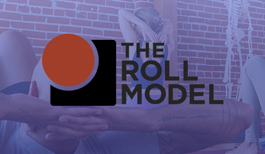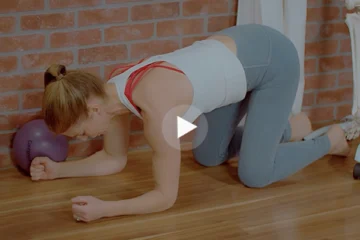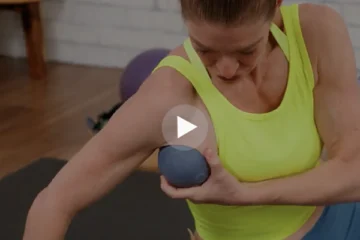
The Pectoralis Major is located on the front of the chest and it attaches to the sterum, clavical and humerus. Its main actions are flexion, internal rotation and adduction of the arm at the shoulder joint and because of its attachment to the clavicle, it can also do some protraction of the scapula. When these actions combine, and if your Pectoralis muscles are strong, it means that you can give some great, big bear hugs- which sounds great. Unfortunately, the Pectoralis Major can also lead to a problem I see too often as a body worker: Slumped Shoulders.

Slumped Shoulders can best be described as what cavemen’s upper bodies used to look like. Shoulders hunched forward and arms internally rotated so that their knuckles could drag. The usual causes of rounded shoulders include poor posture, overuse or sedentary lifestyle (not moving the shoulders enough). When poor posture (which causes adaptive shortening) or overuse occurs the Pectoralis Major becomes extremely tight – this will reciprocally inhibit the posterior shoulder muscles.
Reciprocal inhibition happens because our bodies are built to adapt, so rather than fighting the Pectoralis Major and risking injury, the body overstretches its antagonist muscles. By being in this contracted state the first problem is adhesions or scar tissue will form on the Pectoralis Major, making it more difficult to lengthen without discomfort or injury. It can also cause trigger points to form. Trigger points are areas of hypersensitivity along a muscle fiber which can refer pain. Specifically, trigger points in the Pectoralis Major can refer pain throughout the muscle (chest), into the shoulder and down into the arm, depending on where the trigger point is. The tight Pectoralis muscle can also become so tight that it impinges on the nerves and blood vessels that supply it and the arms. That can lead to decrease of function, loss of sensation or pain radiation down the nerve pathway and loss of nutrient rich blood that feeds the muscles leading to fatigue and pain. On the other side, those posterior shoulder muscles, i.e. rhomboids & mid-trapezius, get fatigued from constantly being overstretched that they cause pain which can feel very similar to what is felt in the Pectoralis Major.
Who is at risk, you may ask? That’s anyone who works with their hands out in front of them for hours a day- so 90% of the population. A shining example for me, living in Fairfield County, CT, would be the commuters. The Wall Street Warriors or Corporate America Captains who spend hours in traffic commuting to NYC – to sit in front of their computers all day – to commute back home again. Most barely take a bathroom break, let alone a break to stretch. This can be cumbersome to their daily lives, dealing with the pain, but it can also greatly affect one’s yoga practice.
As previously discussed, a tight Pectoralis Major can cause rounded shoulders and weakened rhomboids & mid-trapezius. In which poses can these muscles combined cause a snafu in your practice? Inversion poses! Even one as simple as Downward Facing Dog can be affected by misbehaving Pecs and the havoc they wreak. In order to do a strong, well-balanced inversion pose you need a few things: 1- To get your shoulders into the right amount of flexion, 2- To have the ability to retracted and depress the scapulae and to maintain those actions. If a client has tight pecs than both requirements for inversion poses are already compromised. The tight pecs may be limited, as they are always constantly in a contracted state, to get beyond a certain degree of flexion. This has to do with the length-tension relationship of the muscle. The length-tension relationship has to do with the length of the muscle fiber and the force it will produce. Simply stated, if a muscle is too contracted or lengthened, its force will be weaker. In addition, the rhomboids and mid- trapezius would be prime retractors of the scapula but are already weakened. Since the upper body serves as the foundation for inversion poses, if these components are weak than it will lead to diminished poise for the rest of the posture and that could lead to injury.
In order for someone with tight Pectoralis Major muscles to better their yoga practice, as well as normal daily activities, I would recommend the following YTU poses as Pectoralis Major stretches:
Go to wall Squat Arms up with Block – This pose is great practice for correcting your shoulder poise in inversion poses without adding body weight. The chain is still closed at the hands and you have the added bonus of a closed chain at the spine bringing a new proprioceptive awareness to where your scapulae and spine placement are. This can also be used to help strengthen the rhomboids & mid-trapezius muscles.
Epaulet Arm Circles – Helps to bring the shoulders through its full ROM. By having the hands placed on the shoulder joints it really warms up the Pectoralis muscles when bringing the elbows to touch and the rhomboids & mid-trapezius when winging the elbows back in circumduction. This will also bring awareness to the all the muscles of the shoulder girdle complex.
Open Sesame: Uses the floor to pin down & close chain the arm. This allows for the Pectoralis Major to get the deepest stretch possible using body weight & the floor to help horizontally abduct the arm away from the chest.












This makes so much sense. I love your suggestions to start to reverse tight Pec Muscles. So many of us can benefit from incorporating these into a yoga practice. Squat Arms at the Wall is really effective for this — and an amazing way to practice as well. Thank you.
Thanks for the great explanations! You’ve helped me understand better the relationship between the pec major and back/shoulders. People often focus on tight back muscles, not thinking about the fact that their tension might come from the front! I’ll practice these poses and keep using YTU balls to melt down adhesions.
Thanks for the wonderful post! I loved all the exercises and will need to make them a routine. I’m excited to see how they will increase my ROM and better align my shoulders. I know I felt a change after doing the exercises.
As a massage therapist I see this all the time as well in my clients and then i look in the mirror as I’m massaging and realize my shoulders are flexed and internally rotated with protracted scapulae….3 of the 4 functions of the pectorals major. I try very hard to maintain good posture while I’m working and am happy to have found Yoga Tune Up to help me combat my postural downfalls. Thanks for the article.
No wonder I have difficulties with inversions! Light bulb moment! Until I loosen my pectorals major and strengthen my rhomboids and mid traps, no more attempting headstand or handstand. Thank you Lindsay!
I love all your exercises. They really help me with open up my chest and with my shoulder rotation. I’m always having trouble with my inversions and these are some of my go-to exerices.
Love the cave man analogy! So vivid!
Way back in Jan 2012 Janeth asked what Squat Arms Up with Block looked like. No one responded. I don’t know, either. Please explain. Thanks.
Great article. Another common sufferer of this syndrome is body workers. All the over the table working on fixing other people bodies business causes excessive tightness in the pecs. There are great tune up poses for a Bodyworker to add to their daily routine to combat pain and tightness in their upper body!
Very thorough article! I really liked how you brought in reciprocal inhibition as well as the length tension relationship. I’m going to go do my Epaulet Arm Circles now. Thanks for sharing!
This is an awesome breakdown of the pectoralis major! A quick stroll down the street to gander at all the internally rotated and anteriorly pulled shoulders shows us that society needs a better understanding of how this muscle impacts not only our posture, shoulder ROM, and back pain but also our breathing. Using the YTU therapy balls and the exercises you’ve suggested, we can be on the path to reversing this situation!
Dig this post! I like to work inversion exercises in my own practice and have been slowly building my classes to be able to do the same. There are still many people how have a hard time with handstand upper body 90degree angle feet closed chain against a wall. Squat against the wall closed chain with block is a great exercise to offer to those who need to work out the upper body more, while learning the proprioception in the shoulders and chest to be able to understand what it may feel like in handstand or scorpion. Thanks for the training tip, helps me be a better teacher 🙂 !
[…] is not hard to find examples of rounded shoulder posture in the world around you. A large percentage of the population slouches as they walk, sit, […]
[…] of my students and clients have rounded shoulders to one degree or another, but Alicia is probably the most extreme example. She came to her first […]
[…] main complaint, along with the pain and tightness, was that she felt she had “slumped” posture from sitting at her computer for so long. She tried to resolve this by shoving her mid […]
This is great. I always seem to focus on my tight back shoulder muscles, trying to get them loosened up, and I rarely focus on what might be going on in front of me. I spent many years slouching when i was the tall girl that didn’t want to be tall. I also worked many years in corporate america, tied to a computer and desk. The combination has wrecked a bit of havoc. This article sheds a lot of light on what is going on within my pectoralis muscle and ways that I can loosen and strengthen it along with my other, more obvious, shoulder muscles.
Completely agree with this post and Lisa’s comment about seeing this in adolescents. I cringe when I see my young nieces and nephews hovering over a cell phone playing a game or watching a video for hours. I can see these exercises being helpful for students of all ages especially when noticing how modern technology keeps on shrinking while also becoming more accessible to younger customers.
I see too many adolescence with this issue, and I would love to give them some sort of pep talk to get their self-esteem going, but such is not the case, I find also, Bridge Arms into Prasarita may also be highly affective…
What does Squat Arms up with Block look like. I tried googling it, but no dice 🙁
Great suggestions and solutions for the dreaded “Schlumpasana”. Epaulets are my go-to shoulder and pec warm up. It’s so simple and effective. The fact that you remove the arms from the equation really allows you to feel the full range of motion and the pec at the end. Thanks!
This sequence looks incredible for daily use. Accompanying pictures would be awesome.
Most of my students have a tight Pectoralis major, which as you say comes from either underuse slumping forward, or overuse in the gym. With many of them being middle-aged I find starting with epaulet arm circles and shoulder flossing gives an easy warmup. The Pranic bath shoulder minivini gives me a good alternative for students who can’t handle Open Sesame.
Thanks so much for the insights into the consequences of poor posture and tight pecs. I often see strong guys in yoga struggling with inversions because they don’t have full range of motion. They often look baffled because they assume their strength will allow them to muscle their way up.
In all my previous yoga training we were taught the proper alignment in our poses and then modifications. The Yoga Tune Up training course was the first time I was taught how to help students correct their muscular inbalances, limitations, or injuries.
This is a really eye opening article. As someone who commutes two hours a day and sits in front of a computer for eight hours a day, I am definitely at risk of a tight pectorals muscle and the resulting pain in the shoulders and arms. It makes me realize why downward facing dog is still sometimes challenging for me (even after years of practice) and why I am having problems flexing enough in my arms to hold handstand. I will try the suggested YTU poses and see if it helps!
Awesome tips and tricks for the tight Pecs. I am seeing this problem ALL over the place. Whether it be my male clients who have been bench pressing for too long and not stretching enough or the throngs of us in corporate america glued to our desks and computers 8 hours a day. This really gives new meaning to “working stiffs”. I love the idea of sending our students home with some simple assignments to loosen up this area of the body. Hey – we could all use a few more bear hugs, right? Thanks Lindsay!
This is one of the best written articles I have read on Pec Major. It was cleanly written and easy to understand description – not to technical. As stated it is a problem that affects a majority of the population and the three poses offered are great examples that when attempted makes anyone feel better. Thank you.
Thanks for a great article. What a nice dissection of how the tight pectorals can consequently weaken the rhomboids and mid-trapezius, illustrating with the most common and very frequently used yoga posture, the downdog. I am in the process of deepening my understanding of how different agonist and antagonist muscles work to perform yoga postures and how they help us in our day to day life. Yoga tune up training program that I have started to attend from yesterday, is opening the doors in this direction for me too. I love this training and by the end of completing the training and of course the home works, I am confident to get the skill to break apart each pose, in terms of directions of movement and actions of the muscles. I will also hopefully be more skillful to share this with my students.
Loved your article. Since I have been working on stretching the pec major by including the Epaulet arm circles,and open sesame, in my daily practice, my inversions have gotten a lot better, I now do Epaulet arm circles in most of my classes to open up my students upper bodies
I learned so much from this article blog. A well written subject that affects so many of us in our daily lives. I now want to follow your suggested exercises and make them routine. Thank you !
Great article! I work with quite a few men who tend to have really tight pectoralis major. I started to do a variation of open sesame and already see some results.
Thank you!!
Okay–I’m going to do these exercises. I’ll get back to you with my results.
I’m looking forward to a great success.
Great article
My clients love to go out the door with “homework”– simple exercises that can create profound postural improvements and increased flexibility. Both the Epaulet Arm Circles and the Go To Wall Squat Arms Up With Block are easily done at home or in the office. When done midday at the office adding some conscious and stimulating breathwork could make those midday “slumps” and “slumped shoulders” both disappear. My new favorite is the Open Sesame.